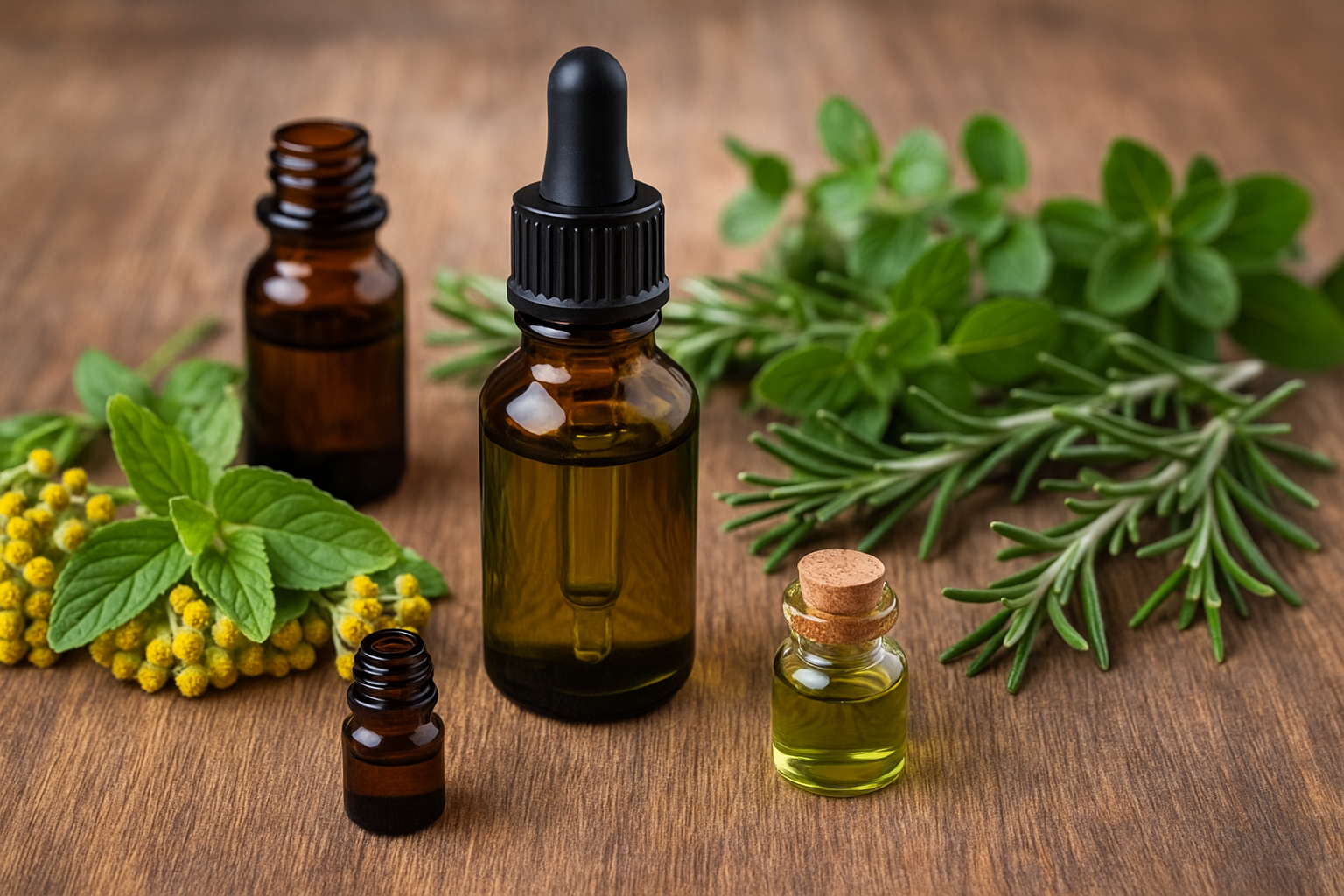Essential oils are concentrated plant essences. They carry not only fragrance but also active compounds that influence mood, health, and memory.
In the Pampas of Southern Brazil, Gaúcho herbs provide unique profiles that stand apart from common lavender or eucalyptus.
Oils made from marcela, rosemary, boldinho, guaco, carqueja, and white sage deliver scents that are authentic and functional.
Blending these oils multiplies their effect. A single drop of rosemary clears the mind, but paired with marcela it balances focus with calm.
Boldinho adds freshness, while sage gives depth. This article shows how to extract, blend, and apply Gaúcho essential oils in daily life, with practical recipes that match modern needs.
What makes Gaúcho oils distinct
Marcela flowers yield a soft, honeyed note rare in global perfumery. Rosemary from the Pampas is sharper and more resinous than Mediterranean types.
Boldinho, little known outside the region, adds mint-like clarity with stronger earthy undertones. Guaco’s sweetness and coumarin content create both fragrance and respiratory support.
Carqueja’s bitterness translates into a dry, grounding aroma. White sage provides smoky resin tied to ritual.
These oils reflect land, wind, and tradition. Using them in blends means carrying cultural identity into sprays, perfumes, and home rituals.
Methods of extraction
Steam distillation
The most reliable method for marcela, rosemary, and boldinho. Plant material is suspended above boiling water. Steam carries volatile compounds into a condenser where oil separates. Yields are small but potent.
Alcohol tinctures
Useful for guaco and carqueja. Leaves soak in neutral alcohol for weeks, creating a fragrant extract. Not as concentrated as distilled oils but easier for home use.
Oil infusions
Leaves or flowers steeped in jojoba or almond oil. Works well with marcela and sage. After two to three weeks, oil absorbs aroma and some active compounds. Good for skin-safe blends.
CO₂ extraction (advanced)
Not common at home, but produces pure oils. Some artisan labs in Southern Brazil explore this for rosemary and sage.
Safety guidelines
Essential oils are powerful. Always dilute before skin contact (1–3% concentration in carrier oils). Avoid direct ingestion. Test on a small skin patch before regular use. Keep away from babies, pets, and sensitive fabrics. Store in amber glass away from heat.
Core single-oil profiles
Marcela
Sweet, floral, calming. Supports sleep and reduces anxiety. Excellent in bedtime sprays and bath oils.
Rosemary
Sharp, green, invigorating. Improves memory and focus. Perfect for study blends and morning showers.
Boldinho
Mint-like, earthy. Refreshes kitchens and bathrooms. Works well in deodorizing sprays.
Guaco
Sweet, soft, coumarin-rich. Supports breathing and relaxes airways. Useful in seasonal diffusers.
Carqueja
Dry, bitter, grounding. Stabilizes blends. Adds depth in autumn or winter formulas.
White Sage
Smoky, resinous. Used for cleansing rituals. Strong, so use sparingly in blends.
Principles of blending
Balance top, middle, and base notes. Top notes open quickly (rosemary, boldinho). Middle notes give body (marcela, guaco). Base notes linger (sage, carqueja). A standard ratio is 3–5–2. Adjust depending on room size and purpose.
Use synergy: rosemary + marcela sharpens focus yet reduces stress. Boldinho + sage refreshes while grounding. Carqueja + guaco blends bitterness with sweet lift.
Keep blends simple. Two or three oils create clarity. More than five risks muddiness.
Recipes for daily blends
Focus blend “Study Wind”
- 6 drops rosemary
- 4 drops marcela
- 2 drops carqueja
Dilute in 30 ml jojoba oil or 100 ml water + 1 tsp alcohol. Mist or apply to temples diluted in carrier oil.
Relax blend “Night Calm”
- 7 drops marcela
- 3 drops guaco
- 2 drops sage
Dilute in 30 ml carrier oil. Rub on wrists or spray on pillows.
Fresh blend “Kitchen Clear”
- 6 drops boldinho
- 4 drops rosemary
- 2 drops lemon peel (optional)
Dilute in 100 ml water + 1 tsp alcohol. Spray after cooking.
Seasonal blend “Autumn Hearth”
- 5 drops marcela
- 3 drops guaco
- 2 drops carqueja
Diffuse in simmer pot or aroma lamp. Warm, steady, and grounding.
Protection blend “Doorway Smoke”
- 4 drops sage
- 4 drops rosemary
- 2 drops marcela
Dilute in oil or alcohol. Spray near doors or use in rituals.
Home applications
Room sprays
Mix blends with distilled water and alcohol. Shake before use. Mist textiles, not air only, so scent lingers.
Diffusers
Ultrasonic diffusers disperse fine mist. Use 5–8 drops per 100 ml water. Change blends by season.
Reed diffusers
Mix oils with carrier + alcohol. Place reeds and rotate weekly. Adds steady background scent.
Simmer pots
Add oils to water with citrus peel. Heat gently. Works well for guaco and marcela.
Cleaning
Add rosemary or sage blends to vinegar-water solutions. Surfaces stay fresh after wiping.
Bath and shower
Add 3–5 drops marcela or rosemary to carrier oil. Stir into bath. For showers, place blend on a warm cloth and inhale steam.
Cultural reflections
Gaúcho herbs are not only functional. They tie families to place. Using marcela in a pillow spray recalls Easter mornings in the Pampas. Rosemary oil connects kitchens to generations of memory. Burning sage links homes to rituals of renewal.
Blending these oils today is a way to keep culture alive while adapting to modern routines. It combines science, sensory pleasure, and heritage.
Mistakes to avoid
Do not apply oils neat to skin. Do not combine too many oils at once. Do not store in plastic. Do not leave diffusers running overnight. Avoid blends that are too heavy for small rooms.
A beginner’s starter kit
1 small bottle of marcela infusion for calm
1 rosemary essential oil for clarity
1 boldinho tincture for freshness
1 sage bundle for rituals
2 glass bottles with spray tops
Carrier oil (jojoba or almond)
This kit supports at least five blends and dozens of daily rituals.
Conclusion
Essential oils and blends from Gaúcho herbs bring the Pampas into modern homes. They last longer than sprays, heal more than candles, and carry memory beyond synthetic perfumes.
With marcela, rosemary, boldinho, guaco, carqueja, and sage, you can design scents that match mood, season, and cultural meaning.
Blending is not complex. Start with two oils, balance notes, and apply in sprays, diffusers, or rituals. Over time, your home builds a signature that is both personal and cultural—a fragrance rooted in land and story.

Marcela Cardozo is passionate about Southern Brazilian traditions and the cultural stories carried through natural scents. She blends knowledge of native herbs, essential oils, and regional rituals to create practical and inspiring content. Her writing connects ancestral wisdom with modern living, offering readers simple ways to bring authenticity, well-being, and meaning into their everyday lives.
